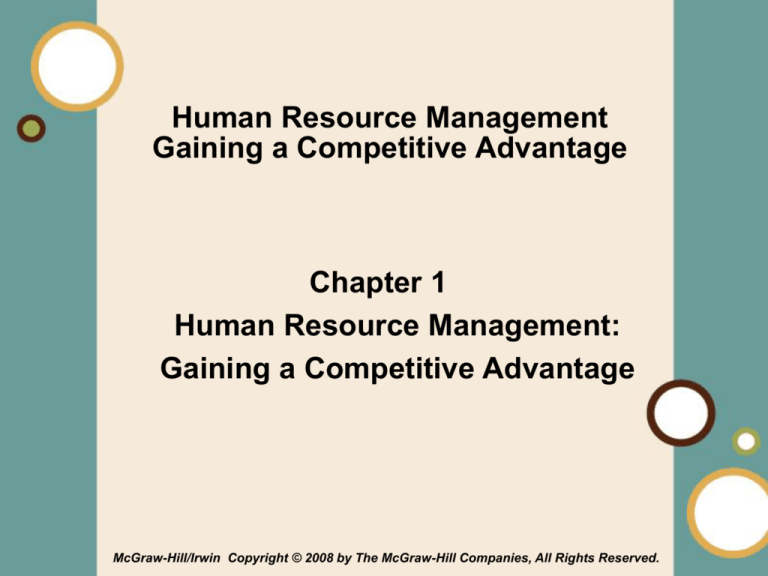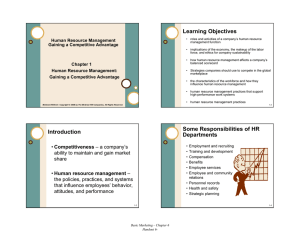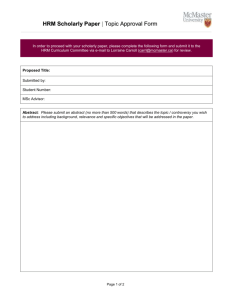
Human Resource Management
Gaining a Competitive Advantage
Chapter 1
Human Resource Management:
Gaining a Competitive Advantage
McGraw-Hill/Irwin Copyright © 2008 by The McGraw-Hill Companies, All Rights Reserved.
1-1
Learning Objectives
After reading this chapter, you should be able to:
• Discuss the roles and activities of a company’s human
resource management function
• Discuss the implications of the economy, the makeup of
the labor force, and ethics for company sustainability
• Discuss how human resource management affects a
company’s balanced scorecard
• Discuss what companies should do to compete in the
global marketplace
• Identify the characteristics of the workforce and how they
influence human resource management
• Discuss human resource management practices that
support high-performance work systems
• Provide a brief description of human resource
management practices
1-2
Introduction
• Competitiveness – a company’s
ability to maintain and gain market
share
• Human resource management –
the policies, practices, and systems
that influence employees’ behavior,
attitudes, and performance
1-3
Responsibilities of HR
Departments
•
•
•
•
•
•
Employment and recruiting
Training and development
Compensation
Benefits
Employee services
Employee and community
relations
• Personnel records
• Health and safety
• Strategic planning
1-4
What Roles Do
HR Departments Perform?
Business
Partner Services
Administrative
Services and Transactions
Human
Resources
Strategic Partner
1-5
What Competencies Do HR
Professionals Need?
1-6
How is the HRM Function
Changing?
• Time spent on administrative tasks is decreasing
and its roles as a strategic business partner,
change agent, and employee advocate are
increasing
• This shift presents two important challenges:
– Self-service – giving employees online access to
information about HR issues
– Outsourcing – the practice of having another
company provide services
1-7
How is the HRM Function
Changing?
• As part of its strategic role, one of the key
contributions that HR can make is to
engage in evidence-based HR.
• Evidence-based HR – demonstrating
that human resource practices have a
positive influence on the company’s
bottom line or key stakeholders.
1-8
The HRM Profession
• HR salaries vary depending on education
and experience as well as the type of
industry
• The primary professional organization for
HRM is the Society for Human Resource
Management (SHRM)
1-9
Competitive Challenges
Influencing HRM
• Three competitive challenges that
companies now face will increase the
importance of HRM practices:
The Challenge of
Sustainability
The Global
Challenge
The Technology
Challenge
1-10
The Sustainability Challenge
• Sustainability refers to the ability of a
company to survive and succeed in a
dynamic competitive environment
• Stakeholders refers to shareholders, the
community, customers, and all other
parties that have an interest in seeing that
the company succeeds
1-11
The Sustainability Challenge
• Sustainability includes the ability to:
–provide a return to shareholders
–provide high-quality products, services,
and work experiences for employees
–increase value placed on intangible
assets and human capital
–social responsibility
–Adapting to changing characteristics
and expectations of the labor force
–Legal and ethical issues
–Effectively use new work arrangements
1-12
The Sustainability Challenge
• The changing structure of the economy
• Skill demands for jobs are changing
• Knowledge is becoming more valuable
– Intangible assets -- human capital, customer
capital, social capital, and intellectual capital
– Knowledge workers – employees who
contribute to the company through a
specialized body of knowledge
– Empowerment – giving employees
responsibility and authority to make decisions
regarding all aspects of product development
or customer service
• Learning organization
1-13
The Sustainability Challenge
Changes in Employment Expectations:
• Psychological contract
• Alternative work arrangements
1-14
The Balanced Scorecard
• The balanced scorecard gives managers the
opportunity to look at the company from the
perspective of internal and external customers,
employees and shareholders.
• The balanced scorecard should be used to:
– Link human resource management activities to the
company’s business strategy.
– Evaluate the extent to which the human resource
function is helping the company’s meet it’s
strategic objectives.
1-15
The Balanced Scorecard
• How do customers see us?
• What must we excel at?
• Can we continue to improve and create
value?
• How do we look to shareholders?
1-16
Customer Service and
Quality Emphasis
• Total Quality Management (TQM)
• Core values of TQM include:
– designing methods and processes to meet the
needs of internal and external customers
– all employees receive training in quality
– promotion of cooperation with vendors,
suppliers, and customers
– management gives feedback on progress
1-17
Customer Service and
Quality Emphasis
• Malcolm Baldrige National
Quality Award
• ISO 9000:2000
• Six Sigma process
1-18
Changing Demographics
Diversity of the Workforce
• Internal labor force is the labor force of
current employees
• External labor market includes persons
actively seeking employment
• The U.S. workforce is aging rapidly
1-19
Managing a Diverse Workforce
• To successfully manage a diverse workforce,
managers must develop a new set of skills,
including:
– Communicating effectively with employees from a
wide variety of cultural backgrounds
– Coaching and developing employees of different
ages, educational backgrounds, ethnicity, physical
ability, and race
– Providing performance feedback that is based on
objective outcomes
– Creating a work environment that makes it
comfortable for employees of all backgrounds to
be creative and innovative
1-20
Legal and Ethical Issues
• Five main areas of the legal environment have
influenced HRM over the past 25 years
– Equal employment opportunity legislation
– Employee safety and health
– Employee pay and benefits
– Employee privacy
– Job security
• Women and minorities still face the “glass
ceiling”
• Sarbanes-Oxley Act of 2002
1-21
Legal and Ethical Issues
• Ethical HR practices:
– HRM practices must result in the
greatest good for the largest
number of people
– Employment practices must
respect basic human rights of
privacy, due process, consent,
and free speech
– Managers must treat employees
and customers equitably and
fairly
1-22
The Global Challenge
• To survive companies must compete in
international markets
• Be prepared to deal with the global
economy.
• Offshoring – exporting of jobs from
developed countries to less developed
countries
• Onshoring – exporting jobs to rural parts
of the United States
1-23
The Technology Challenge
–The overall impact of the
Internet
–The Internet has created a
new business model – ecommerce – in which
business transactions and
relationships can be
conducted electronically
1-24
The Technology Challenge
• Advances in technology have:
–changed how and where we work
–resulted in high-performance work
systems
–increased the use of teams to improve
customer service and product quality
–changed skill requirements
–increased working partnerships
–led to changes in company structure
and reporting relationships
1-25
The Technology Challenge
• Advances in technology have:
–increased the use and availability of
Human Resource Information
Systems (HRIS)
–increased the use and availability of eHRM
–increased the competitiveness in high
performance work systems
1-26
Meeting Competitive Challenges
Through HRM Practices
• HRM practices that help
companies deal with the four
competitive challenges can
be grouped into four
dimensions
– The human resource
environment
– Acquiring and preparing human
resources
– Assessment and development of
human resources
– Compensating human resources
1-27
Meeting Competitive Challenges
Through HRM Practices
• Managing internal and external
environmental factors allows employees
to make the greatest possible contribution
to company productivity and
competitiveness
• Customer needs for new products or
services influence the number and type of
employees businesses need to be
successful
1-28
Meeting Competitive Challenges
Through HRM Practices
• Managers need to ensure that employees
have the necessary skills to perform
current and future jobs.
• Besides interesting work, pay and
benefits are the most important incentives
that companies can offer employees in
exchange for contributing to productivity,
quality, and customer service
1-29








